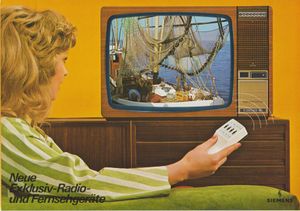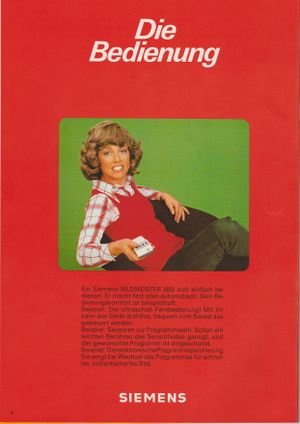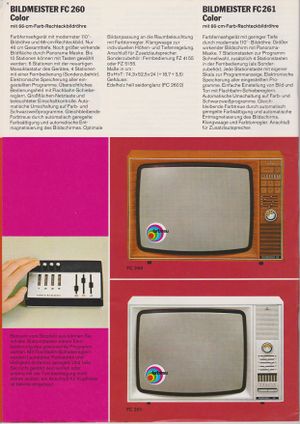Remote control
Innovative remote control solutions from BSH
The first German remote control was launched on the market in 1956. The “Zauberschalter” (magic switch) from Tonfunk was used to switch the accompanying radio on and off remotely. Just how special this technical innovation was for users at the time is clear even from the name. Users in the U.S. adopted a somewhat different slant, however. “Space Commander” or also “Lazy Bones” were the names of the first remote controls for televisions produced there. The name was particularly telling in the case of the “Space Commander” remote control. To activate the TV, a light beam had to be directed at a sensor on the TV. The only problem was that any light beam would activate the sensor, including direct sunlight, for example.
The the remote control began its ascendancy in Germany with the introduction of the color television in 1967. Because these were high-tech devices, many of the new color televisions already came with a remote control. The devices had a button for every TV station, for example, there were six buttons on the Siemens Bildmeister FC 260 Color, which meant that six channels could be programmed. The choice of programs could be extended by an additional four with the FZ 4155 remote control, which could be ordered as a special accessory.[1] Together with the buttons on the TV set, up to ten stations could therefore be controlled. This was perfectly adequate in Germany at the time since the TV landscape in those years was characterized by ARD, ZDF and a handful of regional broadcasters. Private television channels were still banned in Germany up until 1984.
In the 1970s, Siemens remote controls and televisions were fitted with new ultrasonic technology. The Siemens Bildmeister FC 386 teletronic with ultrasonic remote control, which was launched on the market in 1973, was advertised as a luxury item: Viewers could choose between eight programs “like from a command center”.[2] Ultrasonic remote controls emit an audio signal to the TV, which is not audible to the human ear. Up to ten commands could be transmitted to the TV: on/off, volume up/down, picture darker/brighter, enhanced/reduced color, back/forward program.
In den 1980er Jahren wird auf Infrarot-Technik umgeschaltet. Mit der SFH506-xx Serie von elektronischen Bauelementen, die für Frequenzen von 30, 33, 36, 38, 40 oder 56 kHz angeboten werden, gilt Siemens als größter Anbieter für Infrarot-Geräten auf dem europäischen Markt.[3] Neue Empfänger wie Kassettenrekorder entstehen und neue Funktionen, wie z.B. der Teletext, kommen hinzu.
Mit den Sendern PKS (heute Sat.1) und RTL gehen im Januar 1984 die ersten Privatsender auf Sendung. Der folgende sprunghafte Anstieg von Fernsehprogrammen erfordert eine größere Programmauswahlmöglichkeit. Die Fernbedienungen werden komplexer und übernehmen die Steuerung von immer mehr Unterhaltungs- und Kommunikationselektronikgeräten.
Einzelnachweise
- ↑ BSH Corporate Archives, C02-0114, Siemens Radio- und Fernsehgeräte, Prospekte 1967-1978.
- ↑ BSH Corporate Archives, C02-0114, Siemens Radio- und Fernsehgeräte, Prospekte 1967-1978.
- ↑ Walter Fischer: Digitale Fernseh- und Hörfunktechnik in Theorie und Praxis. MPEG-Basisbandcodierung, DVB-, DAB-, ATSC-, ISDB-T-Übertragungstechnik, Messtechnik. 2009.


